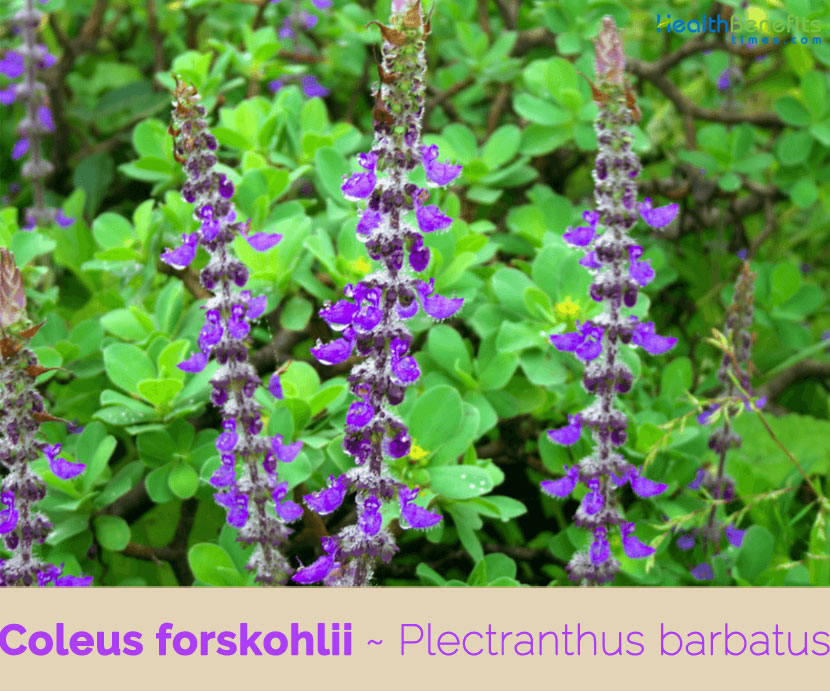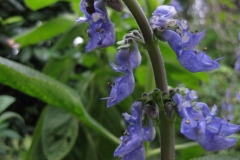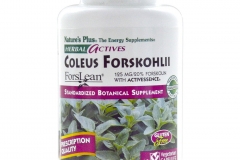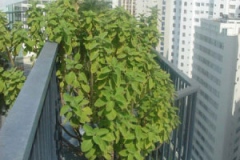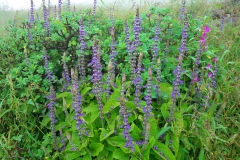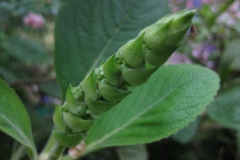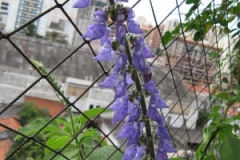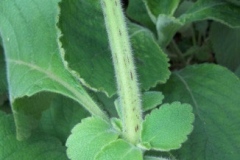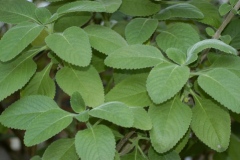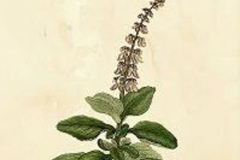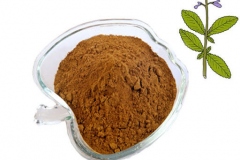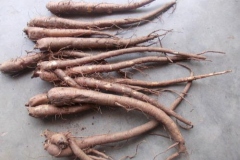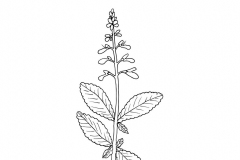| Coleus forskohlii Quick Facts | |
|---|---|
| Name: | Coleus forskohlii |
| Scientific Name: | Plectranthus barbatus |
| Origin | Pakistan, India, Nepal and Ceylon south through Arabia, Sudan, Eritrea, Ethiopia, Somalia, East African, South Tropical Africa |
| Colors | Shiny, dark brown |
| Shapes | Dry, one-seeded, globose, slightly flattened laterally nutlets that are 1.4 x 1.4 mm, included in persistent calyx |
| Taste | Pungent |
| Health benefits | Circulatory remedy, Respiratory problems, Cures Glaucoma,Anti-Hypertensive Benefit, Beneficial for Hypo-thyrodism, Promote weight-loss, Asthma and Allergic Reactions, Boosting Sexual Libido, Treatment of Psoriasis, Relief from Irritable Bowel Syndrome, Boosting Metabolism |
| Name | Coleus forskohlii |
|---|---|
| Scientific Name | Plectranthus barbatus |
| Native | Pakistan, India, Nepal and Ceylon south through Arabia, Sudan, Eritrea, Ethiopia, Somalia, East African, South Tropical Africa and naturalized into southern Africa |
| Common Names | Coleus, Flame Nettle, Painted Nettle, Painted Leaf, Poor Man’s Croton, Ahijado, Dafronaya, Malaina, Mayana, Indian Coleus, Kaffir Potatoe, Abyssinian Coleus, Marundhu Koorkan, False Boldo, Kikuyu Toilet Paper |
| Name in Other Languages | Arabic: Bayidat fwrskwl (بيدة فورسكول) Catalan: Coleus forskholii English: Coleus forskohlii, forskohlii French: Coléus à forskoline, Coléus de l’Inde Gujarati: Garmar (ગરમર) Hindi: Makandi, Patharchur (पत्थरचूर), Pashan bhedi (पाषाणभेदी ) Japanese: Koreusu foresukori (コレウスフォレスコリ) Kannada: Makandi beru, Mangani beru Malayalam: Panikoorka,Makanthi Marathi: Karmelo, Mainmul (माईनमूळ), Garmar (गरमर), Mayin (माईण Or माईन) Nepali: Gandhe jhar (गन्धे झार) Others: Blue Spur Flower,Marundhu Koorkan,Abyssinian Coleus,Gormar,False Boldo,Indian Coleus, Gandhe Jhar Portuguese: Boldo de folhas pequenas, Falso-boldo, sete-dores, Boldo-de-jardim Sanskrit: Pashanabhedi (पाषाणभेदी), Balakah (बालकः), Gandira (गण्डीरः) Tamil: Karpooravalli, Pashanbheda, Patharchur, Maruntu kūrkkaṉ (மருந்து கூர்க்கன்) Telegu: Pāṣāṇa bhēdi (పాషాణ భేది) |
| Plant Growth Habit | Erect, branched, densely hairy, annual or perennial herb |
| Growing Climates | Open dry slopes, dry stony hills, barren hills, grasslands, dry deciduous forests and chir pine forest |
| Soil | Flourishes in well-drained soil in sun or partial shade |
| Plant Size | 45 – 60 cm tall |
| Root | Tuberous, fasciculated, 20 cm long and 0.5 to 2.5 cm in diameter, conical fusiform, straight, orange-red within and strongly aromatic |
| Stem | Erect or ascending, unbranched or with few branches, 20-30 (-60) cm, quadrangular, somewhat sturdy, with long multicellular glandular hairs and short glandular hairs, |
| Leaf | Ovate to oblong, blunt, rounded-toothed, short-stalked, 5-8 cm long. They are arranged in opposite pairs perpendicular to each other, along a 1-3 ft tall stem. |
| Flowering season | August-October |
| Flower | Up to 2 cm long, tube bent abruptly downward, longer than the sepal cup. Flowers are 2-lipped, the upper lip short, turned back, 3-lobed, the lower much longer, boat-shaped, pointed. Sepal cup is hairy, bell-shaped, with lanceshaped, prickly-tipped sepals |
| Fruit Shape & Size | Dry, one-seeded, globose, slightly flattened laterally nutlets that are 1.4 x 1.4mm, included in persistent calyx |
| Fruit Color | Shiny, dark brown |
| Propagation | Stem cuttings or root division |
| Plant Parts Used | Root, Leaves |
| Taste | Pungent |
| Health Benefits |
|
| Other Facts |
|
Plant Description
Coleus forskohlii is an erect, branched, densely hairy, annual or perennial herb that normally grows about 45 – 60 cm tall. The plant is found growing in open dry slopes, dry stony hills, barren hills, grasslands, dry deciduous forests and chir pine forest. It flourishes in well-drained soil in sun or partial shade. Roots are typically golden brown, thick, fibrous and radially spreading. Roots are tuberous, fasciculated, 20 cm long and 0.5 to 2.5 cm in diameter, conical fusiform, straight, orange-red within and strongly aromatic. Stems are erect or ascending, unbranched or with few branches, 20-30 (-60) cm, quadrangular, somewhat sturdy, with long multicellular glandular hairs and short glandular hairs, and with or without red oil globules.
Six other species of Coleus have been explored but only C. forskohlii consists of forskolin. Indian borage (C. amboinicus) is used traditionally within Ayurvedic and Unam Tibb herbal medicine to help reduce inflammation and is prescribed for bronchitis and asthma.
Leaves
Leaves are ovate to oblong, blunt, rounded-toothed and short-stalked. They are arranged in opposite pairs perpendicular to each other, along a 1-3 ft. tall stem. They are 7.5 to 12.5 cm in length and 3 to 5 cm in width, usually pubescent, narrowed into petioles. The plant is strongly aromatic and the leaves have distinctive camphor like scent. Both root and leaves are harvested in autumn.
Flowers
Inflorescence is raceme, 15 – 30 cm long. Flowers are stout, up to 2 to 2.5 cm in size, tube bent abruptly downward, longer than the sepal cup. Flowers are 2-lipped, the upper lip is short, broadly ovate, turned back, 3-lobed, the lower much longer, boat-shaped, pointed. Sepal cup is hairy, bell-shaped, with lance shaped, prickly-tipped sepals. Bracts are broadly ovate, pointed, overlapping in bud, soon falling. The ovary is four parted and stigma is two lobed and the flower is cross-pollinated by wind or insects. Flowering normally takes place from August till October.
Fruits
Fertile flowers are followed by dry, one-seeded, globose, slightly flattened laterally nut lets that are 1.4 mm long and 1.4 mm wide, included in persistent calyx. They are shiny, dark brown colored.
Health benefits of Coleus Forskohlii
Listed below are some of the well-known health benefits of using Coleus forskohlii
1. Circulatory remedy
An important heart and circulatory tonic, coleus is used to treat congestive heart failure and poor coronary blood flow. It also improves circulation of blood to the brain.
2. Respiratory problems
Its antispasmodic action makes coleus valuable for respiratory complaints, including asthma and bronchitis.
3. Cures Glaucoma
Glaucoma is characterized by elevated intraocular pressure (IOP). It is a condition in which the pressure in the eye is too high, due to an imbalance between the formation of aqueous humor in the eye and its absorption in or drainage out of the eye. Eventually, as the pressure builds up, the blood vessels nourishing the optic nerve are constricted, resulting in irreversible damage to the nerve and impaired vision culminating in blindness, if left untreated. Several animal and human research have demonstrated the ability of forskolin to lower IOP, possibly via cAMP activation and a reduction in aqueous flow.
4. Anti-Hypertensive Benefit
Recent research confirmed that coleus consists of a powerful compound called forskolin that may have muscle relaxant properties and can dilate blood vessels thus has a capability to lower blood pressure (anti-hypertensive property). With dilated blood vessels the heart works less to pump blood throughout the body. Coleus can provide health benefit for patients suffering from cardiomyopathy.
5. Beneficial for Hypo-thyrodism
Forskolin found in coleus has been found to regulate various enzymes and hormones in human body. It may be used to control and cure thyroid gland malfunctioning, particularly when the gland is under functioning (hypothyroidism).
6. Promote weight-loss
Active chemical found in Coleus herb is forskolin has been found to promote weight loss in patients who are considered obese. Research has shown that forskolin in coleus can boost the production of enzyme called adenylate cyclase and as a result likewise boost another enzyme called cAMP. This dropping reaction of enzymes forces the fat cells to burn and release their stored energy.
7. Asthma and Allergic Reactions
By stabilizing body cells responsible for the release of histamines, which trigger allergies, and relaxing smooth tissues of the muscle, Coleus Forskohlii is important in the treatment of allergic respiratory conditions such as asthma.
8. Boosting Sexual Libido
Coleus Forskohlii is among the various nutritional supplements recommended for boosting the male hormone testosterone, responsible for sexual vigor. Additionally, by strengthening the heartbeat while lowering blood pressure, sexual performance has been shown to improve using extracts from the herb.
9. Treatment of Psoriasis
Psoriasis is a skin condition characterized by dry, rough, dead skin on the scalp, knees, groin or lower back. The exact cause is not exactly known but scientists suspect a weak immune system could be among the causes. Because of its ability to boost the body’s immune system, Coleus Forskohlii is among the various remedies prescribed for the skin condition.
10. Relief from Irritable Bowel Syndrome (IBS)
It is a disorder of the intestines with symptoms such as irregular bowel movements, abdominal pains, cramps and bloating. Coleus Forskohlii offer relief against this condition by acting on the inflammation of the intestines which aids in the process of digestion thus providing relief against IBS.
11. Boosting Metabolism
It is closely related to providing relief against IBS, Coleus Forskohlii aids in the digestive process by boosting the production of stomach acids thus aiding in digestion thus improving our metabolism.
Traditional uses and benefits of Coleus Forskohlii
- In Ayurvedic medicine Coleus species have been used to treat heart disease, convulsions, spasmodic pain and painful urination.
- It is used as a probable drug for hypertension, congestive heart failure, eczema, colic, respiratory disorders and insomnia.
- It may have therapeutic benefit in asthma, angina, psoriasis, and prevention of cancer metastases.
- Coleus is mainly used to treat dysentery and digestive disorders in India.
- Leaf is used as an expectorant, emmenogogue and diuretic in Egypt and Africa.
- In Brazil, it is used as a stomach aid and in treating intestinal disorders.
- forskohlii has been used for treating heart diseases, abdominal colic, respiratory disorder, insomnia, convulsions, asthma, bronchitis, intestinal disorders, burning sensation, constipation, epilepsy and angina in traditional Ayurvedic system of Medicine.
- Roots are also used in treatment of worms and to alleviate burning in festering boils.
- When mixed with mustard oil, the root extract is applied to treat eczema and skin infections.
- Plant is also used for veterinary purposes.
- Forskolin is also used in the preparation of medicines preventing hair graying and restoring grey hair to its normal color.
- This incredible herb has also proved to be effective for treating skin conditions, improving fertility, controlling diabetes and supporting brain health.
- It helps decrease the body’s stress response, influences fat storage, improves insulin resistance, and reduces inflammation supporting weight loss and weight maintenance.
- It is a traditional herb in India for a wide range of digestive problems. It is given to relieve gas, bloating, and abdominal discomfort.
Ayurvedic Health benefits of Coleus Forskohlii
- Obesity: Make leaves decoction. Take 50 mg twice in a day.
- Hypothyroidism: Steep some Coleus leaves into the lukewarm water. Boil it for one hour to prepare Coleus tea. Strain this infusion and drink it. OR Pluck some Coleus leaves, rinse them well. Just chew it.
- Heart Enlarged: Make a decoction of Coleus leaves and have it 2 times in a day.
Culinary Uses
- Essential oil has potential uses in food flavoring industry and can be used as an antimicrobial agent.
- In Marathi the plant roots are known as MainMula and especially used for pickles.
- It is used as a condiment in India and the tubers are prepared as pickle and eaten.
Precautions
- Avoid use during pregnancy and breast feeding.
- Ulcer, low blood pressure patients should avoid using it.
- There are some reported irritation and sensation of stinging at the point application.
- Coleus may aggravate stomach ulcer.
- When taking blood thinners including warfarin and heparin, coleus are to be taken with caution and with close medical supervision.
- Caution should be taken when under medication for high blood pressure. Blood pressure may go down too low and may cause hypotension symptoms such as dizziness, nausea and light headedness.
References:
https://www.itis.gov/servlet/SingleRpt/SingleRpt?search_topic=TSN&search_value=832863#null
http://www.missouribotanicalgarden.org/PlantFinder/PlantFinderDetails.aspx?kempercode=a547
https://plants.usda.gov/core/profile?symbol=COBA10
https://npgsweb.ars-grin.gov/gringlobal/taxonomydetail.aspx?id=28829
https://www.cabi.org/isc/datasheet/110389
http://www.theplantlist.org/tpl1.1/record/kew-157914
https://www.flowersofindia.net/catalog/slides/Indian%20Coleus.html
https://www.smgrowers.com/products/plants/plantdisplay.asp?plant_id=3922
https://en.wikipedia.org/wiki/Plectranthus_barbatus
https://indiabiodiversity.org/species/show/230788


